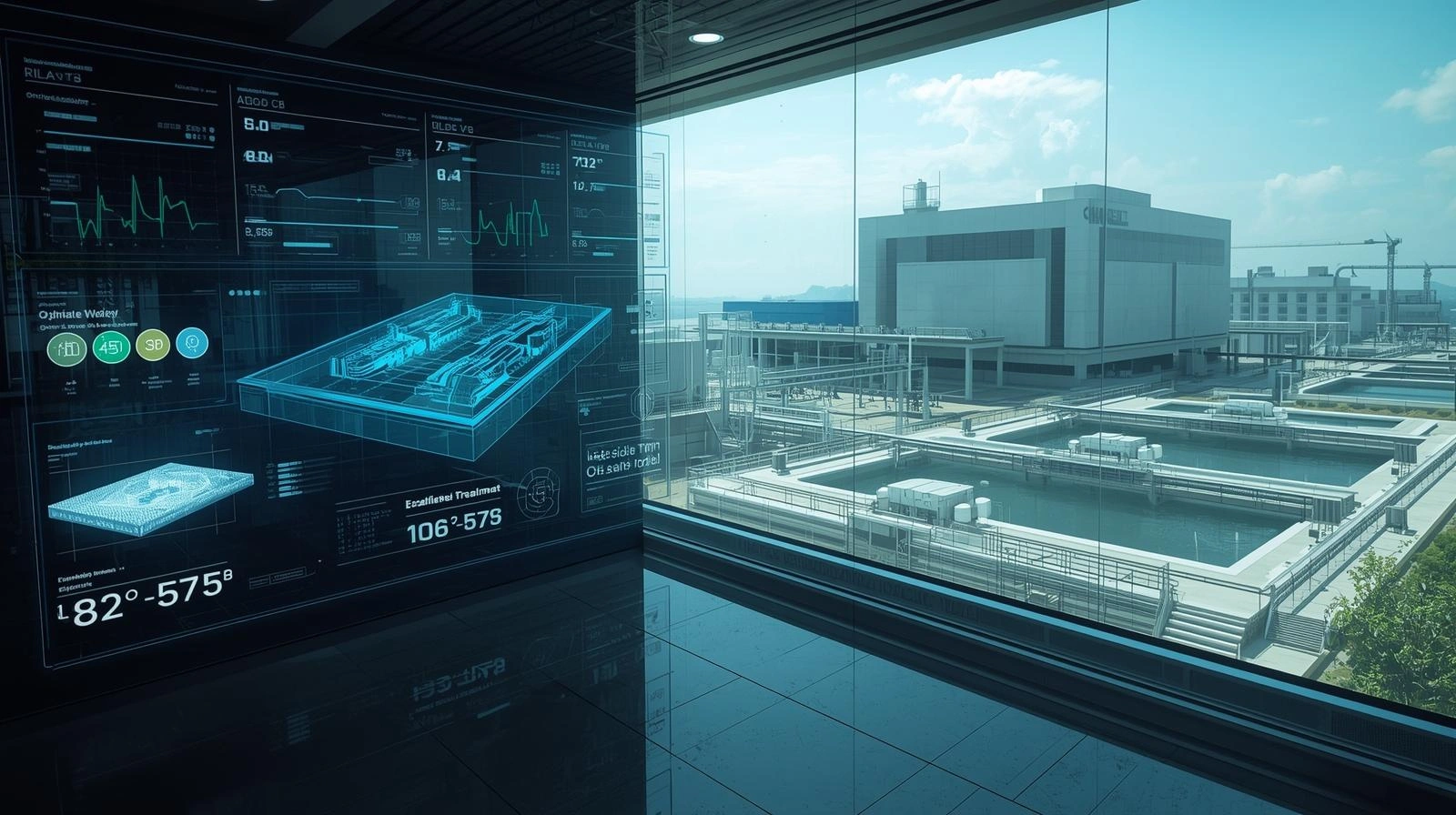Have you ever wondered how large-scale water treatment plants in Pakistan can operate more efficiently while minimizing costs and improving service delivery? As Pakistan faces increasing water scarcity, the need for optimized water treatment systems has never been more pressing. With the rise of smart technologies, one solution that is quickly gaining traction is the concept of Digital Twins. But what exactly is a Digital Twin, and how can it transform the way we manage water treatment in industrial settings?
Digital Twins represent a virtual replica of a physical system, used to simulate, monitor, and optimize operations in real-time. In the context of water treatment, they provide water utilities and businesses with detailed, dynamic insights into their systems, helping to predict, diagnose, and solve problems proactively. In this blog post, we will explore how Digital Twin technology is playing a crucial role in optimizing water treatment processes in Pakistan’s industrial sector, making operations more efficient, cost-effective, and sustainable.
What is a Digital Twin and How Does it Work?
The Basic Concept of Digital Twins
A Digital Twin is essentially a virtual model of a physical asset or system. It is powered by data collected from sensors, devices, and other digital sources that continuously update the virtual model in real-time. In the case of water treatment, a Digital Twin allows operators to visualize how water flows through a treatment plant, simulate chemical reactions, and monitor key performance indicators such as water quality, energy consumption, and chemical usage.
How Digital Twins Integrate with Water Treatment Systems
In water treatment plants, Digital Twins interact with physical infrastructure, such as pumps, filters, tanks, and pipes, to model their behavior. By using real-time data from sensors embedded in the plant’s systems, the Digital Twin can simulate different scenarios, such as variations in water demand, unexpected failures, or changes in water quality. This allows plant operators to make informed decisions about maintenance, optimization, and resource allocation.
Pro Tip: Leveraging advanced data analytics and machine learning within Digital Twin models can significantly improve predictive maintenance, reducing downtime and operational costs.
Why is Digital Twin Technology a Game Changer for Water Treatment in Pakistan?
Addressing Pakistan’s Water Crisis
Pakistan is facing a growing water crisis, with supply failing to meet demand in many areas, especially in industrial sectors. By optimizing water treatment plants through Digital Twins, operators can achieve higher water recovery rates, reduce waste, and ensure more efficient water use.
Real-Time Monitoring for Enhanced Efficiency
One of the primary benefits of Digital Twin technology is real-time monitoring. It provides operators with immediate insights into the plant’s performance, enabling them to adjust operations quickly. In Pakistan, where many water treatment plants struggle with outdated infrastructure, this technology offers a pathway to enhance operational efficiency without the need for significant capital investments.
For example, the Lahore Water and Sanitation Authority (WASA) has been experimenting with Digital Twin technology to monitor water quality and optimize chemical dosing in treatment plants. This not only improves water quality but also reduces chemical consumption, leading to cost savings.
Statistical Insight: According to a 2023 report by the Pakistan Water Partnership, 70% of water treatment plants in Pakistan operate at less than optimal capacity. Digital Twin technology can help improve these figures by offering better management and predictive capabilities.
Wastewater Treatment System
How Digital Twins Optimize Water Treatment Operations
Predictive Maintenance: Minimizing Downtime and Costs
Digital Twins provide predictive insights by analyzing historical and real-time data to forecast when equipment might fail. For example, if a pump is showing signs of wear or irregular performance, the Digital Twin model will signal an upcoming failure, allowing maintenance teams to address the issue before it results in costly downtime.
This is especially important in large-scale water treatment plants, where downtime can affect the entire water supply to surrounding communities or industries. In Pakistan, where resources are often limited, reducing unplanned downtime through predictive maintenance is a significant cost-saving opportunity.
Scenario Simulation for Better Decision-Making
Digital Twins also allow operators to simulate various scenarios and their impacts on the water treatment process. For instance, if there is a sudden spike in water demand during the summer, the Digital Twin can model the impact of increased load on the system, helping operators adjust processes and resources accordingly. This ability to simulate and plan for potential future scenarios is invaluable for optimizing plant performance and ensuring the reliability of water treatment operations.
Energy Efficiency and Resource Optimization
Energy consumption is one of the largest operational costs for water treatment plants. Digital Twins can optimize energy use by adjusting pump speeds, filtration processes, and chemical dosing based on real-time conditions. By minimizing unnecessary energy use, water treatment plants can achieve significant cost reductions, a critical factor in Pakistan’s industrial water optimization efforts.
Expert Insight: According to Mohammad Ali Shah, a Senior Water Engineer at Pakistan’s Ministry of Water Resources, “By adopting technologies like Digital Twins, we can optimize resource use, minimize energy consumption, and improve the overall sustainability of water treatment processes in the country.”
Real-World Applications of Digital Twin Technology in Pakistan’s Water Treatment Industry
Case Study 1: WASA Lahore’s Smart Water Management
The Lahore Water and Sanitation Authority (WASA) has begun incorporating Digital Twin technology into its water treatment plants to optimize water quality management. By monitoring real-time water quality data, chemical dosing, and pump performance, the plant can adjust operations to maintain optimal conditions. This has not only improved water quality but has also led to a noticeable reduction in operational costs.
Case Study 2: The Karachi Water and Sewerage Board (KWSB)
KWSB has started exploring Digital Twin models for its wastewater treatment plants. By simulating water treatment processes in real time, KWSB can optimize filtration, sludge removal, and energy consumption, leading to more efficient water processing. These innovations are helping KWSB reduce costs while maintaining compliance with water quality standards.
Pro Tip: Starting small with a pilot project or a single plant can help stakeholders better understand the benefits of Digital Twins before scaling them to larger operations.
Case Study 3: Textile Industry Water Optimization
The textile industry in Pakistan consumes a significant amount of water for dyeing and washing processes. By integrating Digital Twin technology, textile factories can better monitor their water usage, improve effluent treatment, and reduce water wastage. One leading textile manufacturer in Lahore reduced its water usage by 25% in the first six months of implementing a Digital Twin system, demonstrating the technology’s potential for industrial water optimization.
Overcoming Challenges in Implementing Digital Twin Technology
High Initial Investment
One of the biggest challenges in adopting Digital Twin technology is the initial cost. While the long-term benefits far outweigh the investment, some water treatment facilities in Pakistan may struggle with the upfront costs of sensor installation, data infrastructure, and software systems.
Pro Tip: Government incentives and partnerships with technology providers can help offset initial costs. Additionally, starting with a smaller-scale project or pilot can demonstrate the technology’s ROI before full implementation.
Data Quality and Integration Issues
For a Digital Twin to be effective, it requires accurate, high-quality data. In Pakistan, many water treatment plants rely on outdated infrastructure that may not support modern sensor systems. Integrating legacy systems with new technology can be a challenge, but it’s essential for achieving the full benefits of Digital Twins.
Lack of Skilled Personnel
Digital Twin systems require skilled personnel to interpret data and manage the system. As the technology is still relatively new in Pakistan, training programs and workshops for water treatment operators are essential to ensure successful implementation.
Conclusion
Digital Twin technology is revolutionizing large-scale water treatment in Pakistan, offering a powerful tool for optimizing operations, reducing costs, and improving sustainability. By enabling real-time monitoring, predictive maintenance, and scenario simulation, Digital Twins help water treatment plants address the challenges posed by water scarcity and inefficiency. As the country continues to grapple with water management issues, embracing Digital Twin technology is a critical step toward a more efficient, sustainable, and cost-effective future for water treatment in Pakistan.
Call to Action: If you’re involved in water treatment or industrial operations in Pakistan, consider exploring how Digital Twin technology can optimize your processes. Reach out to industry leaders and technology providers to begin your journey toward smarter water management.
FAQ
Q1: What is a Digital Twin?
A Digital Twin is a virtual model of a physical asset or system that simulates its behavior using real-time data. In water treatment, it helps optimize plant operations.
Q2: How can Digital Twins help with predictive maintenance?
By analyzing historical and real-time data, Digital Twins predict equipment failures before they occur, reducing downtime and maintenance costs.
Q3: Is Digital Twin technology cost-effective for water treatment plants in Pakistan?
Although the initial investment can be high, the long-term savings from reduced energy costs, improved efficiency, and better resource management make Digital Twins highly cost-effective.
Q4: What industries in Pakistan are using Digital Twin technology for water treatment?
The textile industry, water utilities like WASA Lahore, and wastewater treatment plants like KWSB are beginning to adopt Digital Twin technology to optimize water usage.
Q5: What challenges do water treatment plants in Pakistan face with Digital Twin implementation?
Challenges include high initial costs, data integration from legacy systems, and the need for skilled personnel to manage the technology.
Q6: How can Digital Twin technology help in energy optimization for water treatment?
Digital Twins can adjust water treatment processes in real-time, minimizing unnecessary energy consumption, leading to significant cost savings.
Q7: Can Digital Twins be used for both wastewater and drinking water treatment plants?
Yes, Digital Twin technology is adaptable to both wastewater and drinking water treatment plants, offering benefits across the water treatment sector.


